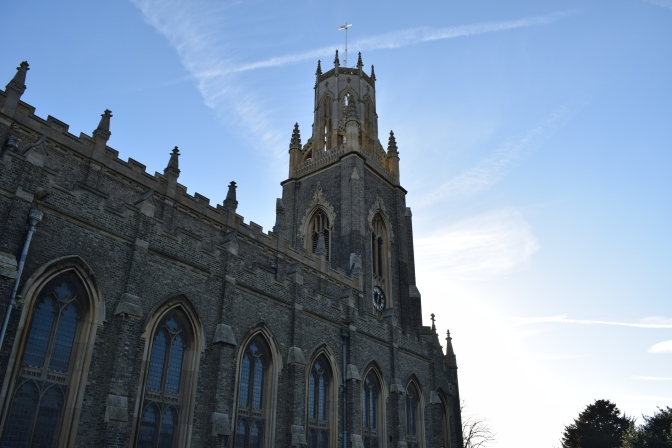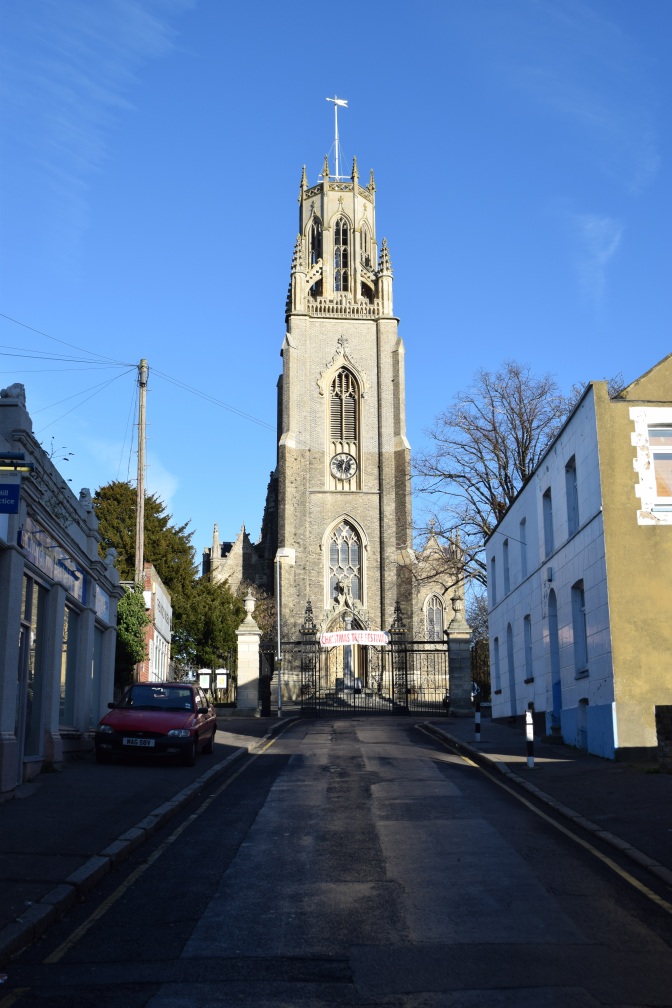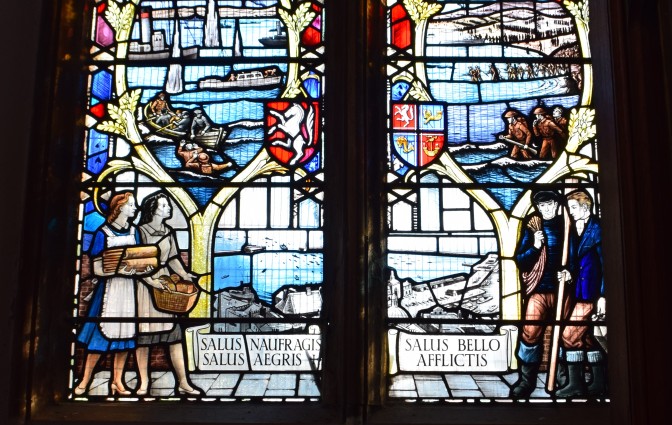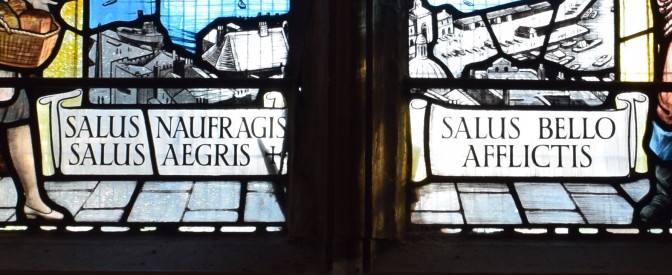“Before it is too late, I have tried to recapture the extraordinary beauty of this bird and to convey the wonder of the land he lived in, a land to me as profuse and glorious as Africa. It is a dying world, like Mars, but glowing still.”
J.A. Baker, ‘The Peregrine’

My family were miners and arrived in Kent in the 1920’s. They rode the train- and walked- from South Wales. They came to dig coal and most never went back to the old country. The first records I can trace show that my great grand-parents lived on the High Street in Ramsgate, within the Parish of St George’s Church. The next generation lived there for a while too, before moving in the 1950’s to live on the shiny new miners’ estate at Newington, near the edge of town. Lots of relatives have since returned to the parish and in my twenties I rented a flat on the High Street for a summer- about two hundred yards up from the church.
I still use St George’s occasionally and it was on Christmas Eve a few years ago that I first heard about the peregrines. After the carols, I overheard several elderly ladies lamenting an increase in the amount of dead pigeon carcasses they were encountering around the church building. The new birds were seen as dangerous interlopers; bullies from God-only-knows-where.
“The army used to shoot the buggers!” exclaimed Doris.
There followed a lengthy and enthusiastic discussion as to who else needed ‘shooting’ in modern Britain. Tony Blair and Jonathan Ross did not come out well.
During mince pies and sherry, I got talking with the girls and found a group of warm-hearted but very vulnerable people. Their religion has contracted and England is changing at an unprecedented rate. For reasons that are understandable from their point of view, they’ve become highly suspicious of change and newcomers. Needless to say, they didn’t share my overt enthusiasm for the arrival of the world’s fastest airborne predator. In fact, the fastest animal on the earth, full stop. The peregrines were seen as yet another exotic addition to a fast-moving, dangerous world. Too quick, too violent, and just too damned full of themselves, was the final impression. A bit like those ‘Yanks in the war’, one of the ladies quipped; to this day, the birds are only grudgingly accepted by the church’s nervous (but very lovely) inner circle.
The birds may have received a different welcome if they chose St Laurence, just a short walk up the road. The church there, like many others in the UK, follows a policy of ‘controlled overgrowth’. The resulting mini-jungle provides a paradise for tits, robins, goldcrests, woodpeckers and jays- whilst restoring a subtle romance to the tired, ancient head-stones. However, the church building itself is a small one. You can see exactly why the peregrines turned their noses up and carried on down the road to St George’s, whose steeple affords them an excellent vantage point from which they can hunt, rest and hopefully one day- breed. Which is what they deserve, as the past century has been deeply unkind to them.

When I was a child, the peregrines were extinct in Kent. Several ornithologists have speculated that a huge number of modern English peregrines (particularly in London and the South) are in fact ‘Welsh’ peregrines. The descendants of migrants, looking for a new place in another part of the land. I can’t say whether the local peregrines share my Welsh blood but it’s a pleasant fantasy to which I readily subscribe. What I do know is that their modern history is one of the very most tragic in the animal kingdom.
To explain this, I must firstly refer to St George’s, in whose eastern wing there stands a magnificent section of stained-glass named the ‘Dunkirk Window’. It depicts the landings of the British Army evacuees in 1940- many thousands of whom landed on Ramsgate beach, just a few hundred yards to the south-east of the church.

The inscription at the base of the windows reads the town’s Latin motto:

‘Safety to the shipwrecked and the sick. Safety to those hurt in war.’
There can be no question that the peregrines are victims of our wars. In World War One, the Ministry of Defence was forced to order a mass cull of the species. The chief reason was simple… Pigeons. The peregrines are, in the main, a pigeon-fancier; they constitute the main part of their diet. Tragically for peregines, pigeons constituted the cream of our messenger-bird service; once trained up, they flew vital intelligence to and from the front line in Belgium, and so became not only a cherished species but also a highly protected one.
So it became a crime not to shoot peregrines. The cull was reinstated during the second world war and stayed in place until the early 1960’s, in case a Soviet nuclear attack melted down our more modern communication methods. But by this point a new, even more sinister development awaited them: DDT and the other similarly lethal insecticides were now in widespread use on British farms. Once these poisons had fully soaked into the food chain, many of the surviving peregrine clans were doomed to die demented, chemical deaths- a fate many times worse than being shot.
The small, ragtag bands of remaining birds retreated north to the high country, or else west to the Welsh mountains.
The writer J.A.Baker was the most powerful documenter of this shameful chapter in our natural history. Any reasonable human who has read ‘The Peregrine’ will be haunted by it for the rest of their days. Set over ten years, it catalogues the slow death of an entire genus of the birds who wintered along the Essex coastal mud-flats. The vivid descriptions of the peregrines’ prostate, gagging deaths provide a searing censure of mankind’s failure to manage the countryside in the interests of the wider animal kingdom.
Baker would, I’m sure, be relieved to know that the peregrine has returned to the countryside. Not only that, it’s colonized every major city in England. But he would also be wary; if nothing else, his writing screams to all naturalists that we must stand vigil. Many of us intend to do just that; over the past few years, many small groups of dedicated followers have formed to watch over and protect the birds as their advent continues apace in England. What’s more, it’s not only animal lovers who are fiercely protective of the birds; they have the ability to warm the hearts of those who ordinarily have no interest whatsoever in wildlife. In doing so, they win a double victory for conservation.
For me, to see a peregrine’s death dive (the famous ‘stoop’) was a childhood dream; I now regularly observe it on nearby streets and along the coastline where my father taught me to fish. Most miraculously of all, they haunt the grounds of the church that welcomed my family nearly a century ago. I’m not the first person to photograph or watch any of these local birds- and am far from the most qualified to do so. In fact, I’ve only recently bought a camera lens that can get anywhere near them. But their journey to this town has a personal significance for me.
It’s become important to me that I watch them and occasionally, I hope to photograph them and write a little about their surreal beauty.
So long live the advent of the dragons, I say…
Because they’ve been away far too long.

Wonderful writing. So much chimes with me. My nuclear family made the opposite journey to yours – from Kent and London/ Essex esturies to South Wales (where I became ‘culturally Welsh whilst genetically English’). When choosing to raise my own family I returned to roost in Ramsgate (with extended family nearby). The peegrine was an object of wonder to me growing up. It was the creature that ignited a lifelong interest in birds. The fact that there were only 50 breeding pairs at one point in the past was etched into my soul as a reminder of how fragile ecosystems are, and how powerful human intervention can be (for good or ill). Lovely writing. I am so glad to have discovered it. Thank you.
LikeLiked by 1 person
That’s immensely kind of you to say, Jacqui… Wow, that’s a quite a journey. East to West and back again… I adore the countryside, but anywhere near the coast (even our local graveyards!) attract such a variety of birdlife… Not too sure how the peregrines will get on with the local parakeet population. Thus far I’ve seen none of the latter anywhere near a peregrine haunt. I agree wholeheartedly with your sentiments on human intervention. The peregrine is a totem for our impact on the animal world… Merry Chrismas and thanks immensely for reading- Gareth
LikeLike
I see Baker is getting a lot of bad press of late, his writing is now had to be unscientific fiction. I just find it to be beautiful writing. We have peregines in Norewich., nesting on one of our two cathedrals.
LikeLiked by 1 person
Hello Stephen- I’m with you, mate- Baker’s terrific! He is to nature writing what Ted Hughes is to poetry…. Such a startling and clear vision. Whenever I read that book, he transports me straight onto the mudflats with him; it’s better than any photograph… I’m glad to hear you have them on the cathedral in Norwich… Isn’t it awesome that such a stunning creature would choose such fittingly Gothic abodes in which to reside?
LikeLike
Thank you for a very informative and interesting read. It is great to have these birds back along our coastline and town. Wouldn’t it be great if a local school or college in conjunction with the church could install a nest box to encourage these birds to breed there. I have been watching and filming these birds for a number of years. They actually appeared in a short film on BBC Springwatch this year.
I certainly hope others will appreciate how lucky we are to have these magnificent birds back in our town 🙂
LikeLiked by 1 person
Hello Keith- That’s fantastic! As are your wonderful photos. Is the Springwatch film still available? The coastline is changing now they’re back. I bass fish each summer and noticed them in Dover about 15 years ago- they do seem to have gradually colonized Kent and I’m with you- it’s magic; especially for someone who didn’t record more than three or four raptor sightings as a kid around here. Now I’m spoilt for choice… But it shouldn’t be taken for granted; and you’re right- there should be a box up there for them. I’m at the church for the carol service on Thursday… The issue is local support. They’re an incredibly nice bunch but as I said in the blog- their inner circle is a little tremulous about anything like this. The birds are still not exactly welcomed by the congregation. It’s better than it was, though- it’s as though they’re now grudgingly accepted… I teach locally and would love to get some school pupils involved. I’m setting up a junior countryman’s program where I work (fishing/birding- the lot, hopefully) and I’ll bring this up- perhaps the involvement of school children could secure the birds’ home there? It’s an ideal location for them- and it will also save the C of E money on pest control, if they want to look at it that way (not that they’re interested in money…!)- Happy Birding and Merry Christmas, Gazza
LikeLiked by 1 person
It’s not officially available as they are only on iPlayer for a few weeks. However I made a copy for myself https://youtu.be/Q2hkL0m25yE The birds in the film are the ones seen at the church stooping into Courtstairs Park. I helped with the filming of this back in the spring.
A nest box would be so great to have on the church and if they could install a web camera as an IT project think of that 😉 But as you say it would need their support. I guess they need to read your Blog and understand what a privilege it is to have these birds back and to choose their church 🙂
If it ever did go ahead I’d love to film it 🙂
LikeLiked by 1 person
That was a fantastic view, Keith! Very, very good video. ‘Edgelands’, indeed- wow… My dad used to work on the hoverport (when it was one) as an engineer. Like you, I prefer it the way it is now… You’re right about St George’s, mate… Let’s see what we can do…
LikeLike
Interesting & informative article Gareth. Let’s hope the peregrines battle on – do they eat Gulls – wouldn’t be a bad thing and plentiful supply in Thanet.
LikeLiked by 1 person
Hello Demos- Thanks for the kind comment; as for the gulls, I’m not sure, actually! They must take the odd one, but I’ve not seen it yet. The St George’s pair are pigeon fanatics (the lower parts of the main building are like their larder) but I’ve seen them ‘quarrel’ with the local gulls, as it were. Chase each other back and forth etc. But no stoop-attacks…
LikeLike
Gareth, Absolutely delightful with social history in the warp and weft of the post. Amazingly we’ve got peregrines in the fens they nest way up the mighty pylons. I’ve just come back from walking the two terriers and we were followed by a sparrow hawk who was hoping we’d flush her supper. Sadly Barney, our old terrier at twelve, has congestive heart disease but the pills have worked and hopefully he’ll make another four years or so. The cold doesn’t help him so it’s a walk late afternoon for him but he’s happy enough. The drains and river are frozen solid so I’m carrying on with the new site. I loved the comment about Blair and Ross, made me laugh out loud. Nearly 16.30 so time for a pint I think.
Kind regards, John
LikeLiked by 1 person
Hello John- Nice one! I’ll be off for one later. The local stocks several nice ales; anything golden is my favourite. It won’t be long until it warms up and I can get a couple of the really hoppy ones down my neck.
With regards to this peregrine, I actually went and bought a long lens specifically for this spot. It’s come in very handy since with kingfishers and barn owls. The main bird that resides there had offspring last year and one is thriving.
We get them much more on the local cliff tops but it fascinates me when they occupy old buildings. And pylons, too- that is intriguing. How lovely that they can thrive up your way courtesy of human intervention, too.
In Kent, the electricity companies have started putting a scent on their new wooden poles to deter woodpeckers! Apparently the birds mistake the poles for trees and build nests in them… Hopefully, we’re planting enough trees to house the powerline refuges (!)- there are many more woodpeckers in Kent than when I was a child…
Enjoy that beer!- Gazza
LikeLike